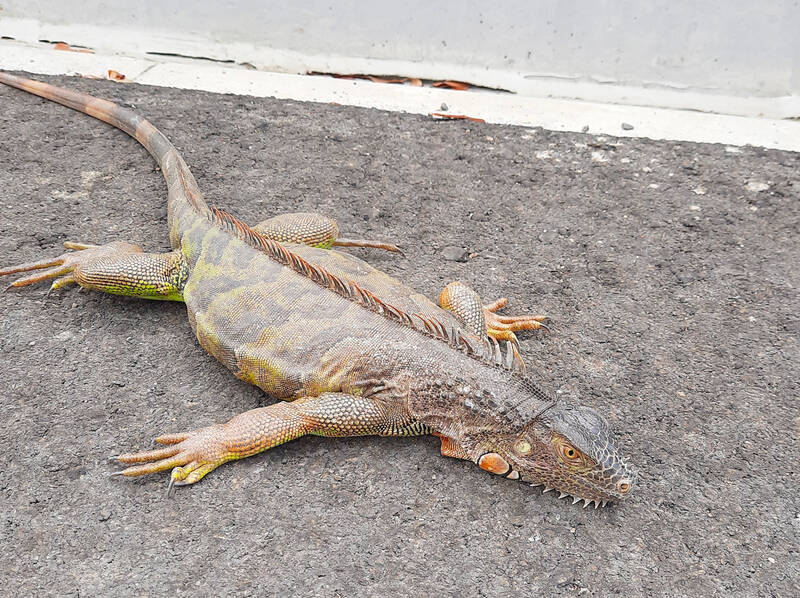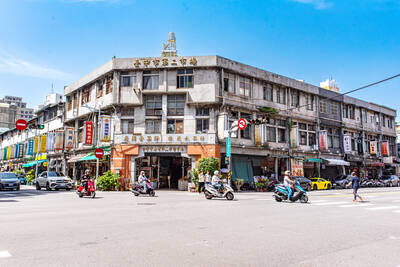Tainan’s Sanye Creek (三爺溪) isn’t by any stretch of the imagination a tourist attraction. For years, it was the worst-polluted tributary of one of Taiwan’s most degraded rivers. These days, however, it makes for pleasant cycling, especially if you’ve an aversion to traffic and gradients.
This 14.4km-long waterway also looks and smells a good deal better than you’d expect, if you were to research its postwar history. Alternatively known as Sanyegong Creek (三爺宮溪) or Sanlaoyegong Creek (三老爺宮溪) — names which suggest there’s a temple on its bank — its source is somewhere in Yongkang District (永康). That part of Tainan is famously industrial, but the main cause of Sanye Creek’s environmental woes was a cluster of downriver smelting operations which dumped solid and liquid waste into its slow-moving waters.
The creek isn’t out of danger. On Apr. 14, the Liberty Times (sister newspaper of the Taipei Times) reported that officials had investigated an aluminum processing enterprise and confirmed that it illegally discharged “strongly acidic and harmful wastewater … with a pungent smell.”

Photo: Steven Crook
The enterprise’s owners admitted that, since 2019, they’d been pumping contaminated water into the creek about once a week, always in the early hours of the morning.
After a few rides along Sanye Creek, I realized it’s actually an excellent place for one type of ecotourism. It isn’t unusual to encounter at least one hideous yet impressive fully-grown green iguana. This invasive species has become notorious in the past decade for muscling out native lizards, all of which are much smaller.
INVASIVE LIZARD

Photo: Steven Crook
The common green iguana, originally from Latin America, was introduced to Taiwan as an exotic pet after a ban on keeping them was lifted in 2001. Some specimens escaped. Others were abandoned by owners unwilling or unable to look after them once they’d reached a meter or more in length. It’s also suspected that local pet traders deliberately released the species for future harvesting. Whatever the cause, within a decade, wild populations had established themselves throughout the southwest.
Between 2014 and mid-2019, more than 7,000 feral iguanas were captured at various locations. Since then, the authorities have stepped up their war against the species. This summer, TaiwanPlus reported that more than 40,000 have been removed from the wild. But despite the incentives the government has been offering to hunters, it’s obvious that plenty of green iguanas have avoided capture.
Stomach contents analysis of trapped iguanas indicates that they feed mainly on paper mulberry (Broussonetia papyrifera), a shrub that often grows where the land has been disturbed by development. They sometimes eat crops.

Photo: Steven Crook
Iguanas have a habit of digging burrows beside waterways. This could destabilize a river’s banks, but it’s hard to see how that would happen to any part of the Sanye Creek, which for almost its entire length is encased in concrete. This NT$5.1-billion pour-and-pave project, completed last year, was justified on the grounds of flood prevention.
BIKE EXCURSION
Probably the best place to begin a bike excursion along the creek is Rende Detention Basin (仁德滯洪池), just northeast of Chung Hwa University of Medical Technology (中華醫事科技大學). If you’re coming from central Tainan, take Dongmen Road (東門路, also known as Road 182) eastward, and brace yourself for a sharp right turn after Carrefour, just before the road goes under Freeway 1. You’ll see the basin’s ponds almost immediately.

Photo: Steven Crook
As far as Detang Road (德糖路), it doesn’t matter whether you ride on the right or left banks. But south of that intersection, stick to the right (northwest) bank, or you’ll find yourself running out of road beneath Expressway 86. Just inland of the main north-south railway line, where what’s now called Ten Drum Cultural Village (十鼓文創園區) occupies a long-shuttered sugar refinery, I’ve often seen adult iguanas basking in the sunshine. I’ve also come across dead specimens.
The height of the flood-prevention wall prevents iguanas from fleeing down to the water. When cornered, they don’t seem to be brave or intelligent enough to dash across the asphalt and disappear into the undergrowth. The best way to get closeup photos, I’ve found, is to stay on my bike and chase them until they’re too exhausted to object to my invading their privacy. A couple of short sprints and they’re worn out.
The railway blocks the embankment road, but it’s possible to cut through Ten Drum’s parking lot to a level crossing and cycle southward on Wensian Road Section 1 (文賢路一段). Within 600m, a right turn will put you back beside Sanye Creek.
FURTHER RIDING
It doesn’t matter much whether you ride on the north (right) bank or the south (left) bank. The former has more greenery. From both it’s possible to see the European-style dome of Chimei Museum (奇美博物館) and the buildings of Chia Nan University of Pharmacy and Science (嘉南藥理大學). And whichever side you choose, it seems to be impossible to cross Provincial Highway 1 in a way that’s both safe and complies with traffic laws.
Once across the highway, ride on the south (left) bank for around 400m, turn right over the first bridge you see, then immediately turn right again. Follow the road past the glass-recycling plant. It veers left and goes beneath the expressway.
Tainan Airport is located just north of the creek. It’s a dual-use military-civilian facility, and some aviation enthusiasts come here to watch fighter jets take off and land. If you want to access the best viewing points on the north (right) bank, you’ll need to do so from Tongsing Road (同興路), close to where Sanye Creek flows into the Erjen River (二仁溪).
At the time of writing, the left-bank levee road between Tongsing Road and the point of confluence was closed due to construction. Via Jhongjheng West Road Lane 1073 (中正西路1073巷), it’s possible to get onto the government-designated bike trail that can take you westward to Tainan’s less-than-inspiring coastline.
There are two bridges for cyclists here, and from them I like to look out over the wetland that has formed where the creek empties into the river. I always see plenty of birds and dragonflies, as well as the occasional iguana. I’m not convinced that confining waterways between artificial embankments of sterile concrete is the right thing to do — but at least this local ecosystem shows signs of life.
THE TEMPLE BEHIND THE NAME?
If Sanye Creek did get its name from a place of worship, it’s probably Sanjia Sanye Temple (三甲三爺宮). This shrine is approximately 700m southeast of where Expressway 86 crosses the waterway, between Sanjia 7th Street (三甲七街) and Baoan Road Section 2 (保安路二段) in Tainan’s Rende District (仁德).
Depending which source you believe, the temple was established in 1717 or 1751. The central altar enshrines three Wangye (王爺) spirits who are for ritual purposes treated as a single entity known as Sanye (三爺).
The most interesting thing I’ve discovered about this temple is that some locals claim Sanye is actually a pseudonym for Cheng Cheng-kung (鄭成功, also known as Koxinga). Cheng is famous in Taiwan for ejecting the Dutch from their Tainan outpost almost 400 years ago. However, his diehard loyalty to the Ming Dynasty meant that, during the succeeding Qing Dynasty, Taiwanese who wished to honor him had to do so in secret.
Steven Crook has been writing about travel, culture and business in Taiwan since 1996. He is the author of Taiwan: The Bradt Travel Guide and co-author of A Culinary History of Taipei: Beyond Pork and Ponlai.

May 11 to May 18 The original Taichung Railway Station was long thought to have been completely razed. Opening on May 15, 1905, the one-story wooden structure soon outgrew its purpose and was replaced in 1917 by a grandiose, Western-style station. During construction on the third-generation station in 2017, workers discovered the service pit for the original station’s locomotive depot. A year later, a small wooden building on site was determined by historians to be the first stationmaster’s office, built around 1908. With these findings, the Taichung Railway Station Cultural Park now boasts that it has

Wooden houses wedged between concrete, crumbling brick facades with roofs gaping to the sky, and tiled art deco buildings down narrow alleyways: Taichung Central District’s (中區) aging architecture reveals both the allure and reality of the old downtown. From Indigenous settlement to capital under Qing Dynasty rule through to Japanese colonization, Taichung’s Central District holds a long and layered history. The bygone beauty of its streets once earned it the nickname “Little Kyoto.” Since the late eighties, however, the shifting of economic and government centers westward signaled a gradual decline in the area’s evolving fortunes. With the regeneration of the once

The latest Formosa poll released at the end of last month shows confidence in President William Lai (賴清德) plunged 8.1 percent, while satisfaction with the Lai administration fared worse with a drop of 8.5 percent. Those lacking confidence in Lai jumped by 6 percent and dissatisfaction in his administration spiked up 6.7 percent. Confidence in Lai is still strong at 48.6 percent, compared to 43 percent lacking confidence — but this is his worst result overall since he took office. For the first time, dissatisfaction with his administration surpassed satisfaction, 47.3 to 47.1 percent. Though statistically a tie, for most

In February of this year the Taipei Times reported on the visit of Lienchiang County Commissioner Wang Chung-ming (王忠銘) of the Chinese Nationalist Party (KMT) and a delegation to a lantern festival in Fuzhou’s Mawei District in Fujian Province. “Today, Mawei and Matsu jointly marked the lantern festival,” Wang was quoted as saying, adding that both sides “being of one people,” is a cause for joy. Wang was passing around a common claim of officials of the People’s Republic of China (PRC) and the PRC’s allies and supporters in Taiwan — KMT and the Taiwan People’s Party — and elsewhere: Taiwan and